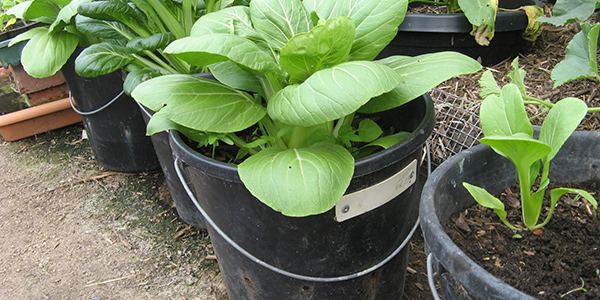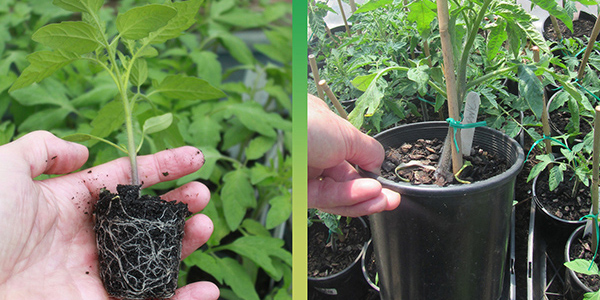Using Commercially Grown Vegetable Seedlings
There is nothing wrong with using commercially grown vegetable seedlings, especially if you are a novice gardener. But they have both advantages and disadvantages over their home-grown cousins. This pages explains the pros and cons of using commercial seedlings.
Before going out and buying seedlings check whether the vegetables you want to grow are suitable to plant as seedlings or are best sown directly as seeds. Unfortunately, many nurseries stock seedlings of vegetables that do not transplant easily. For a list of seedlings that are easy to transplant see the Seedling Planting Suitability Chart page.
- EASIER TO GROW
As long as you are using seedlings that are easy to transplant bought seedlings are easier to grow than home grown seedlings as you avoid the risks associated with growing the seedlings from scratch. - NO WAITING TIME
Commercially grown seedlings can be bought and planted on the same day, whereas if you want to use your own seedlings you have to start growing them four to six weeks ahead of when you want to plant out. - GOOD AS STOPGAPS
Bought seedlings are good stopgaps for when seedlings you are growing yourself fail or are not ready in time.
- EXPENSIVE
Bought seedlings are much more expensive than buying seeds and growing your own seedlings. You usually only get eight seedlings per standard punnet and in Australia punnets generally retail for around $3:50 each (2020 prices). Whereas a standard packet of seeds usually yields enough seeds to grow at least twenty punnets worth of seedlings. - LACK OF DIVERSITY
If you were to list the different varieties of vegetables available as seedlings you would only fill a few pages, but if you listed all the different vegetables found in the various seed catalogues you would end up with a very large book. Growing your own seedlings hugely expands the variety of vegetables that you can grow. - RELATIVELY WEAK SEEDLINGS
Commercial seedlings are grown under ideal conditions with plenty of water, heat and fertiliser to grow them as quickly as possible. This tends to produce seedlings that are more likely to be stressed when first planted in the garden as they are not used to the tougher conditions. - NOT AS ENVIRONMENTALLY FRIENDLY
Most commercial seedlings are grown hundreds of kilometres from where they are sold, and a lot of fuel is used to truck them across the country. Transporting seeds uses much less fuel. Also< the punnets that they come in are only used once. If you grow your own seedlings not only will less energy be used producing them but the punnets and pots used to grow the seedlings can be used repeatedly.
BUY LOCAL SEEDLINGS IF POSSIBLE
If you must buy seedlings then try and buy ones that are grown locally by small operators. These seedlings are usually tougher than the ones grown by large wholesale nurseries as they are not forced (grown quickly under ideal conditions) and are grown under local conditions. Local seedling growers can often be found at farmers markets. Some nurseries and agricultural supply stores also stock local seedlings. Local seedlings can usually be spotted as they are generally grown in non-standard containers such as Styrofoam cups or even just wrapped in paper. If you are unsure then simply ask the vendor where they were grown.
DO NOT BUY SEEDLINGS THAT HAVE BEEN STRESSED DUE TO LACK OF WATER OR BEING LEFT TO GROW TOO BIG FOR THE PUNNET
Seedlings that have dried out at any stage should never be bought as lack of water often triggers vegetables to bolt (go to seed). By buying and planting them not only will you be wasting your money you will be using up valuable space in the vegetable patch, the crop they will produce is likely to be stunted and of poor quality.
This also applies to seedlings that have grown too big for their punnets. Some nurseries offer seedlings that have grown too big at discounted prices, but do not waste your money on them. Only buy seedlings in prime condition.

Seedlings for sale at a local nursery. The carrot seedlings on the right are a good example of nurseries selling seedlings that are not suitable to be planted as seedlings. Carrots planted as seedlings will almost always produce poor quality split carrots, they do much better when sown directly as seeds.
ADVANTAGES SUMMARY
ADVANTAGES
- Easy to grow.
- No waiting time.
-
Good as stopgaps for when home grown seedlings fail.
DISADVANTAGES SUMMARY
DISADVANTAGES
- Expensive.
- Lack of diversity.
- Weak seedlings.
- Not as environmentally friendly.




